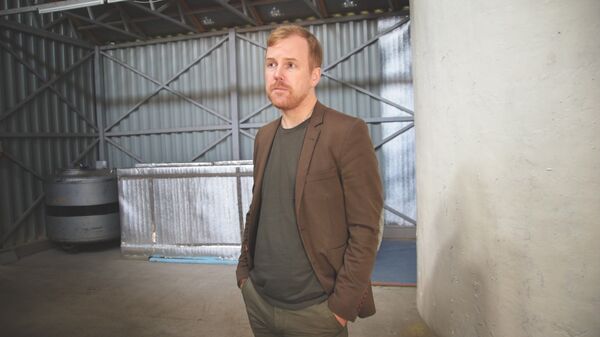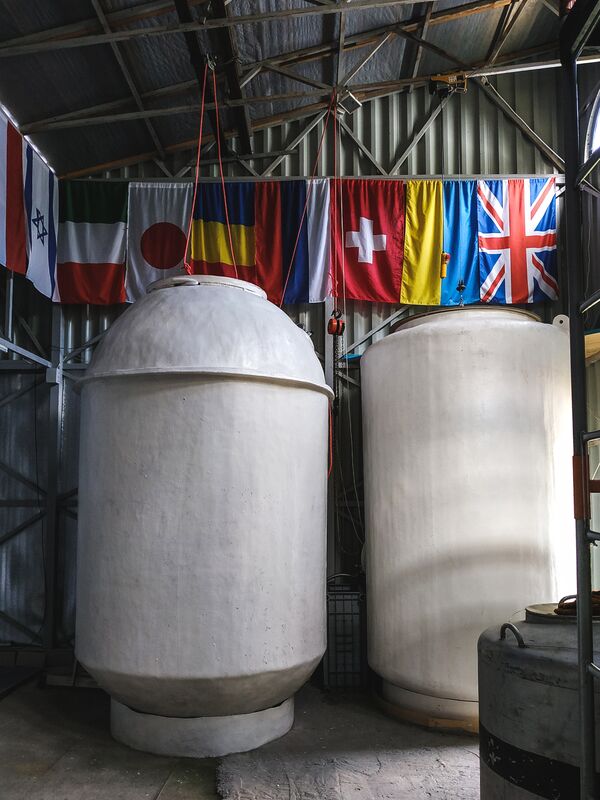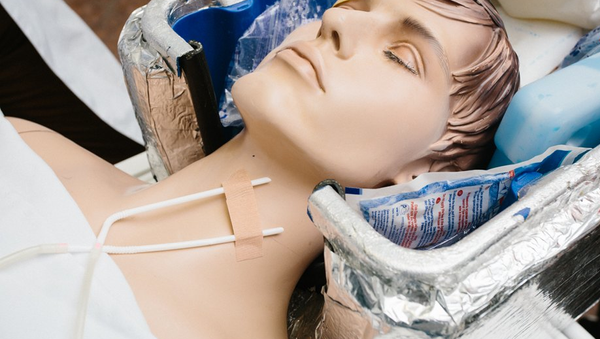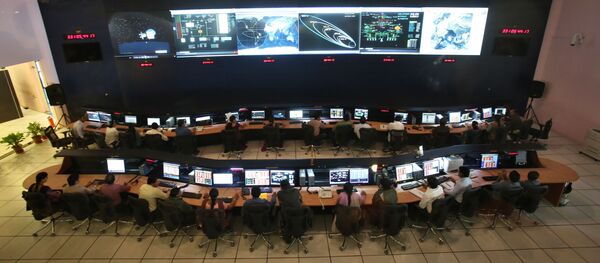Sputnik's interlocutor has a medallion with a phone number and instructions for what to do if he dies. So it's highly likely that if he dies he will end up where he and Sputnik have come.
Freeze Your Own Grandma
Danila Medvedev is a 38-year-old futurist, transhumanist and Chairman of the board of the Russian company KrioRus. The company was founded in 2006 and, as you can guess from its name, deals with the question of how to preserve the bodies of dead people for a future awakening.

The industrial building is a cryoreservoir where the frozen bodies of 64 Russians, Australians, Americans, Italians (4 of them), Israelis and other nationals are immersed in liquid nitrogen in cryostatic capsules; there even are some pets. The bodies are placed in vertical containers where the temperature is —196°. Here there are former terminal cancer patients, beloved relatives, believers, and non-believers. A special tool is used to place them inside the containers, and to take them out.
On the walls, there are the flags of the patients' home countries.
It's like being at an Olympics, only that the prize here is, for now, the theoretical possibility of returning to life.
Heart of Ice
First and foremost, to come back to life in the future it's necessary to notify the state and your family that you want to be cryonized. According to Medvedev, there are several ways of doing that — starting with writing a simple note to drawing up a will. You also need to sign a contract with a cryonics company and indicate exactly how you want to be cryopreserved.
The cost for the services offered by KrioRus to foreigners is $18,000 for the conservation of the brain alone and $36,000 for the entire body. The company covers all the logistics. Procedures should be performed right after death. If the doctor is duly prepared (but very few are), he/she can proceed alone to the clinic where the patients spent their last days. It's also possible to book the assistance of a KrioRus expert team in advance.
Initially, it's necessary to keep the body in the cold, for instance in a mortuary, but it would be wrong to suppose that cold is the key element for preservation. In fact, no two colds are alike. If a body is frozen in a freezer, the water will crystallize in the cells and body tissues, inevitably causing them to be destroyed when the body is defrosted.
Spike in My Veins
For this reason, a perfusion procedure is preferred: after the blood is extracted from the body, a special solution — a cryoprotectant, containing glycerine, ethylene glycol, and other substances — is injected into the veins and arteries. Then the patient can be frozen to 0° and then to —40°; once the temperatures reach —80°, the patient can be placed into the cryoreservoir where he/she is frozen at —196°.
"If the procedure is performed properly, it's possible to almost completely avoid ice formation and there'll be no damage to the tissues," Danila Medvedev says.
This technology is called vitrification — it is the transition from a liquid state to a glass state. Vitrification, or the freezing of embryos and their subsequent thawing and transfer to a uterus, is also used in cases of infertility. In addition, vitrification experiments in rabbit kidneys have demonstrated good results, which is important for both cryonic procedures and transplantation.
According to Medvedev, cryonics can make it possible to preserve donor organs for months and even years. Moreover, considering the development of 3D printing, "we will be able to pick up a person's DNA and elaborate an organ compatible with his/her organism" in the future.
Brain Death, How to Cure It?
Logically speaking, it is not necessary to freeze the whole body. The important thing is to cryonize the brain. But here's the problem, the brain's death is the way that many nations interpret the death of a person. When this irreversible condition appears in Russia, for example, it's permissible to deactivate an ALV system.
READ MORE: The Future is Here! Human Body Cryogenically Frozen for First Time Ever in China
However, Medvedev admits that only modern medicine considers a dead brain actually dead:
"Almost all the brain cells are alive and all the structures are preserved, so if you rely on simple reanimation, but not cryonics, you will die; but if you believe that in the distant future there will be new technologies, then the brain's death is not a problem," Medvedev says.
Die Predictably and Don't Smoke.
According to Medvedev, if you wait for too long, at some point death will be completely irreversible, as "all the information of your personality will be completely destroyed."

Then asked if it makes sense to resort to cryonics if a body with signs of violent death is found 5 days after the time of death, the expert replied that it makes no sense. In this case, it's only possible to organize cryo-funerals, but it's just a ceremony: there is no second-life guarantee. So, for now, cryonics can help only those whose death is predictable: at home or in a hospital.
And more precisely, those who lead a healthy lifestyle:
"Those who take care of the cardiovascular system, and ensure there are no accretions on the vascular walls have the most advantages; and for those who don't do that, the situation may be more complicated," Medvedev explains. At the same time, the expert admits that nanomedicine can solve this problem too.
FB Likes Could Get You a Second Life
However, if there is no brain or it is now "compromised", it still will be possible to try to bring a person back to life with a cryonized DNA. But how can you "put together" a personality?
"Today we talk a lot about this aspect in relation to big data: everything we do is recorded in a video, audio or even through a keyboard. This information describes us and in theory, it can be used to restore a surrogate of our personality that speaks like us and has our memories. Clearly, at some point, it will be possible to create digital copies that at first sight will be equal to a particular person, but I think this is not enough," Medvedev explains.
No Frankenstein Experiments
The Russian biophysicist Igor Artyukhov once said: "If they manage to freeze and then revive at least a mouse, I think there will be long queues for cryonic companies." But when will we be able to say that we have carried out the first experiment on human beings with a positive result?
Danila Medvedev believes it could happen in about 50 years. It might only sound like science fiction if you don't keep in mind that 50 years ago science fiction was what we do today.
"When cryonics was born, there was no mention of head or organ transplantation: DNA structure and even cloning hadn't yet been discovered. When in the 1950s and 1960s Robert Ettinger, the father of cryonics, wrote ‘The Prospect of immortality', he thought that the restoration of human brain activity was theoretically possible, although many associated that primarily with Frankenstein's experiments and the creation of monsters. However, today every hospital has a resuscitation department that does exactly what Ettinger wrote about," Danila says. Medvedev started to take an interest in cryonics after he had translated the book into Russian.
Immortality: Russian Invention, Developed by Americans
It all started a long time ago. Porfiry Bakhmetev, the son of a Russian peasant and the great Russian-Bulgarian biologist and physicist, came up with the very first idea to restore vital activity through the cold. Bakhmetev had studied the phenomenon of anabiosis due to animal frigorism since the late 19th century, and he was the first to create anabiosis in mammals (in bats).

As Danila Medvedev explains, the desire to use these technologies on humans also captured the attention of other scientists. Konstantin Tsiolkovsky, the founder of theoretical cosmonautics, also showed great interest in the theories of immortality and macrobiotics. Then, in the 60s in the US they began to find practical applications for cryonics. At the moment there are two large cryonic companies in the US and one in Russia, namely KrioRus. But virtually all countries are interested in this industry.
"For a long time, various countries have been cooperating internationally, for example, one of our thermostatic coolers has been created thanks to the technologies developed at the US Institute of Cryonics; however the vitrification technology used by the US institute was created by Yury Pichugin, first Soviet and then Russian scholar in the field," Medvedev explains.
Hard Drive Control
Medvedev believes that at the moment a significant part of the path has been completed on the way to bringing cryopatients back to life. However, many questions remain unanswered. And when the long awaited day comes and experts arrive at Semkhoz station to take the company's customers from the cryoreservoirs, they will have to check a huge amount of data and defragment our so-called hard drive:
"Our brain alone has more than 10 billion neurons and 100 billion cells, and each neuron has about 10 billion proteins each performing a different job. The neurons have between 10,000 and 100,000 synapses, in other words, connections with other neurons; and the experts must check this complex structure for errors and then restore or replace the damaged parts."
According to Medvedev, it will take decades before technologies are invented that allow us to work on billions of cells simultaneously through microsurgery and nanomedicine.
Cryonics? God Bless it…
When asked how cryonics agrees with religion, Danila explained that "the faith in the resurrection is probably the pillar of the Orthodox religion and of Christianity in general. According to the Bible, Jesus said that not only He could raise the dead but anyone who believes and wants it."
"Since culture was born, man has always thought of immortality and has always wondered whether a man was immortal in the past but then was deprived of this privilege, or whether immortality doesn't exist and it's up to us to find it," the expert concludes.
Coincidence?
However, the correspondent swears that this was only a coincidence and that it's not yet his time.


